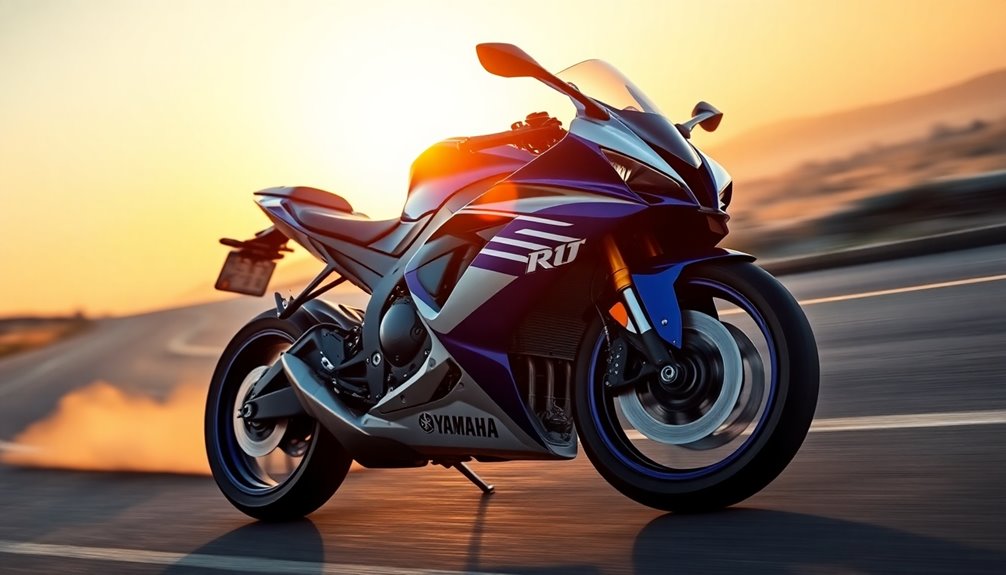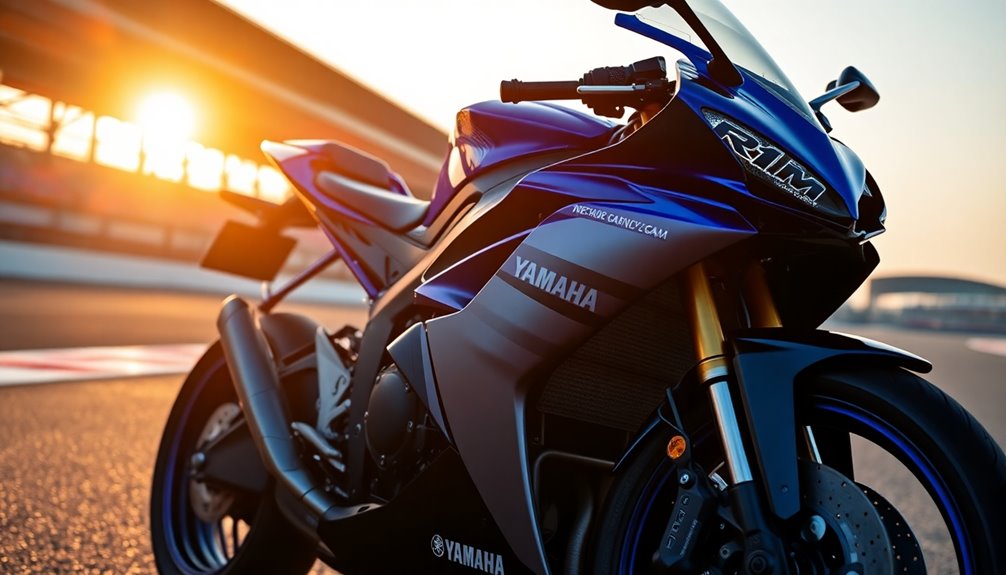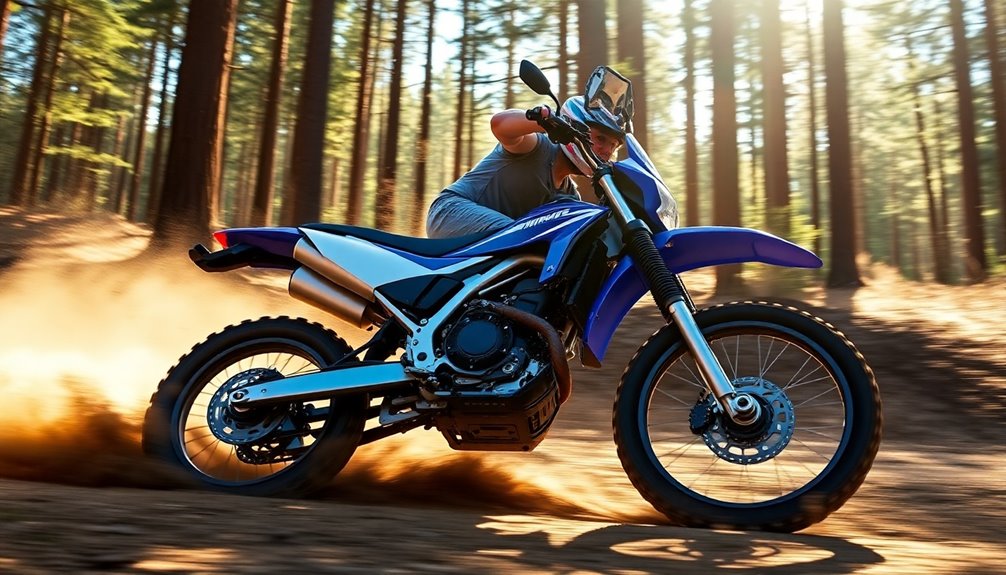The Yamaha R1 pushes superbike boundaries with a top speed of 186 mph, electronically limited by a Gentleman's Agreement. Its powerful 998cc engine produces an impressive 197 horsepower, enabling rapid acceleration from 0-60 mph in just 3.0 seconds. Advanced electronics, like the Yamaha Chip Controlled Throttle and a six-axis IMU, enhance stability and performance at high speeds. The bike's aerodynamic design further improves control, making it a favorite among enthusiasts. With its combination of power, handling, and cutting-edge features, the R1 stands out in the competitive superbike market. When you explore further, you'll uncover even more thrilling aspects of this legendary machine.
Key Takeaways
- The Yamaha R1 achieves a top speed of 186 mph, electronically limited by the Gentleman's Agreement.
- Its powerful 998cc inline-four engine produces 197 horsepower, enabling rapid acceleration and exceptional performance.
- The bike features advanced electronics like traction control and launch control, enhancing stability at high speeds.
- Innovative aerodynamic design, including carbon fiber winglets, improves downforce and front-end stability for better handling.
- The R1's high-performance suspension and braking systems contribute to its ability to maintain control during aggressive riding.
Advanced Electronics Integration
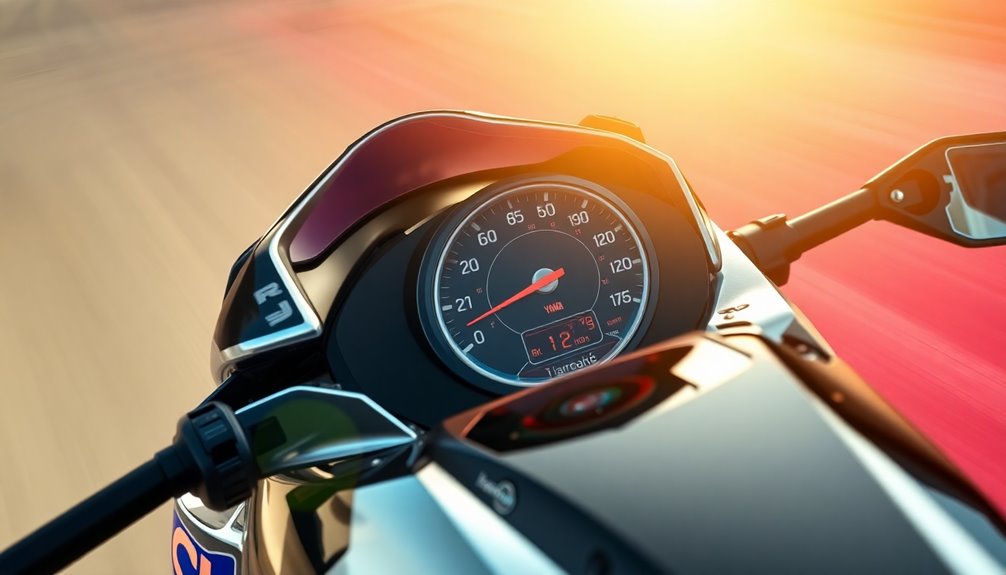
The Yamaha R1's advanced electronics integration plays a crucial role in maximizing performance and control. You'll appreciate how the Yamaha Chip Controlled Throttle (YCC-T®) system eliminates throttle cables, allowing for smoother and more responsive throttle operation. This seamless interaction enhances your riding experience, giving you greater confidence in various conditions.
With the Yamaha Chip Controlled Intake (YCC-I®), the R1 ensures a broad power spread across the entire RPM range, making it easier for you to find the right power at any moment.
The six-axis Inertial Measurement Unit (IMU) continuously measures movement in 3-D space at 125 calculations per second, providing real-time data to the Engine Control Unit (ECU). This integration allows for detailed analysis of bike position and movement, enhancing overall handling. Additionally, the advanced braking system with high-friction brake pads ensures reliable performance in various conditions, contributing to your safety and control.
You're also equipped with rider-assisting technologies like the Engine Brake Management (EBM) system, which offers three levels of engine brake force adjustment for smoother corner entries.
The Lean Angle-Sensitive Traction Control System (TCS) and Slide Control System (SCS) adapt to your riding style, ensuring optimal performance while you push the limits of the R1.
Engineering Excellence Unleashed
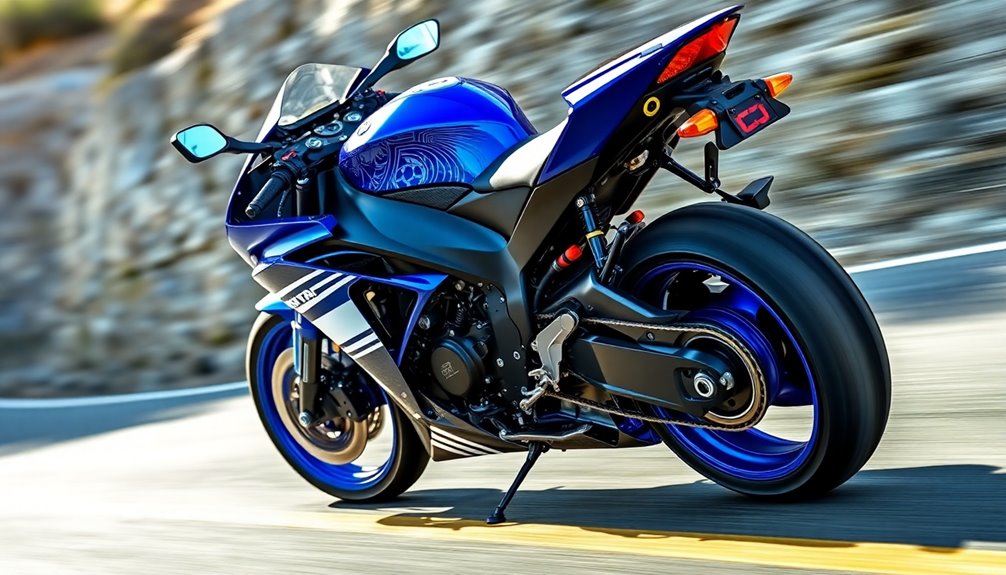
When you unleash the Yamaha R1, you're tapping into a perfect blend of maximum velocity and thrilling throttle response. The aerodynamic design not only cuts through the wind but also enhances stability at high speeds. This engineering excellence ensures you're not just riding; you're experiencing the pinnacle of motorcycle performance. The 2004 model, for instance, showcased a top speed of 189 mph, demonstrating the bike's ability to push the boundaries of superbike performance.
Maximum Velocity Achieved
Achieving an impressive top speed of 186 mph, the Yamaha R1 exemplifies engineering excellence in the world of superbikes. This speed is electronically limited due to the Gentleman's Agreement, which aims to keep speeds around 300 km/h to avoid regulatory measures. While some competitors, like the April RSV4, can exceed this limit, the R1 maintains its reputation as a top performer among liter bikes.
At the heart of the R1 is a powerful 998cc inline-four-cylinder engine that churns out 197 horsepower at the crank. This engine, equipped with a crossplane crankshaft and titanium fracture-split connecting rods, enhances both performance and weight efficiency. With peak torque at 79 lb/ft, the R1 accelerates rapidly, reaching 0-60 mph in just 2.6-3.0 seconds. The engine features a short-stroke design, which contributes to its high-revving capabilities and overall performance.
Aerodynamic MotoGP-style bodywork complements a meticulously designed chassis, ensuring stability at high speeds. The bike's advanced electronics, including a six-axis inertial measurement unit, further enhance control during intense acceleration.
As you push the R1 to its limits, you'll feel the synergy of power, design, and technology, culminating in a thrilling ride that embodies superbike mastery.
Throttle Response Dynamics
While riding the Yamaha R1, you'll immediately notice its exceptional throttle response, a testament to advanced engineering that enhances your control and confidence on the road. The ride-by-wire Yamaha Chip Controlled Throttle (YCC-T®) system eliminates traditional throttle cables, allowing for precise sensing of your input. This technology ensures that the throttle valves react seamlessly, controlling intake volume without sudden bursts of power.
With the Accelerator Position Sensor with Grip (APSG), every twist of the throttle is accurately detected, providing smooth and quick engine response. The R1's 998cc inline-four-cylinder engine, using crossplane crankshaft technology, delivers linear torque that connects directly between your throttle grip and the rear wheel. You can tailor engine response to your riding style through the Power Delivery Mode (PWR), which offers four progressive settings. This engine features a 20-valve design that maximizes power output at high RPMs, enhancing overall performance.
The integration of electronic rider aids further enhances your experience. The Lean Angle-Sensitive Traction Control System (TCS) adjusts intervention based on your lean angle, while the Slide Control System (SCS) fine-tunes power delivery.
This level of control means you can push the limits with confidence, knowing that the R1 is engineered for precision and performance.
Aerodynamic Design Efficiency
With its sleek and aggressive design, the Yamaha R1 showcases an impressive aerodynamic efficiency that directly contributes to its performance on the track.
The 2025 models, including the YZF-R1 and YZF-R1M, feature new carbon fiber aerodynamic winglets developed through Yamaha's extensive MotoGP® racing program. These winglets generate additional downforce, enhancing front-end stability during braking and cornering, making your ride feel more secure. This design is akin to the high refresh rates found in gaming projectors, which also improve performance by providing smoother visuals. Furthermore, the integration of heat pump mechanics in vehicle design can optimize energy efficiency, paralleling the innovative approaches seen in motorcycle engineering. Additionally, well-drained soil is crucial for the longevity of any garden, much like the importance of stability in a high-performance motorcycle. Efficient systems such as heat pumps can significantly reduce energy consumption, aligning with the engineering excellence of the R1.
The bike's fully redesigned 43mm KYB front fork improves road response and feel, delivering better stability and feedback as you tackle corners. Coupled with a lightweight aluminum Deltabox frame, this setup creates a compact chassis that enhances handling. The addition of new Brembo front brakes significantly improves braking power, allowing for sharper stops and greater confidence in high-speed scenarios.
If you opt for the R1M, the Öhlins Electronic Racing Suspension adjusts damping in real-time, ensuring optimal performance whether you're on the street or track.
Additionally, the new radial-mounted Brembo Stylema monobloc front brake calipers, paired with a new Brembo master cylinder, provide superior braking power and feel, enhancing your overall control. The bike's impressive color accuracy during high-speed maneuvers contributes to the rider's ability to navigate with precision.
The seamless integration of these aerodynamic features with the bodywork results in an unmistakably aggressive profile, ensuring the R1 maximizes both performance and handling on any ride.
Rider Feedback on Comfort Levels
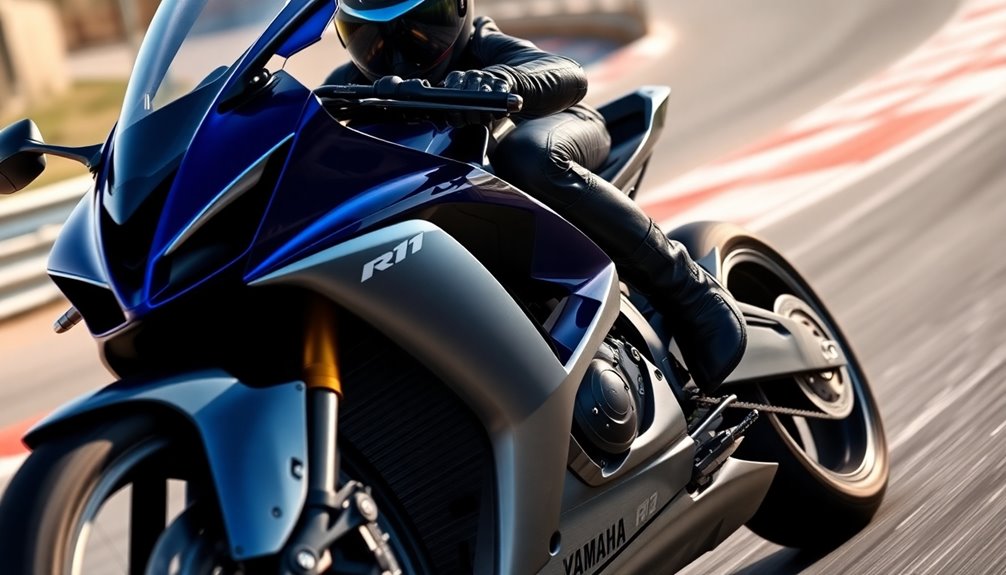
Rider feedback on comfort levels for the Yamaha R1 reveals a mix of satisfaction and concern. The ergonomics strike a balance between sports and cruising, making it comfortable for town riding and smaller roads. If you're around 5'11.5", the reach to the bars feels just right.
However, if you're over 6 feet tall, you might find the seating position a bit cramped, especially with high footpegs that can be uncomfortable for taller riders.
While the bike excels in corners, giving you the confidence to push hard, aggressive riding positions are great for track day enthusiasts. The suspension is well-tuned for track performance, and high lean angles are manageable without scraping your pegs. Additionally, the bike's 30% increased rigidity contributes to its responsive handling, enhancing the overall riding experience.
On the flip side, passenger comfort is lacking. The high passenger seat can lead to thigh cramps, and they might slide forward during braking or gear shifts, making the ride uncomfortable.
Owner Insights: Real-World Experiences
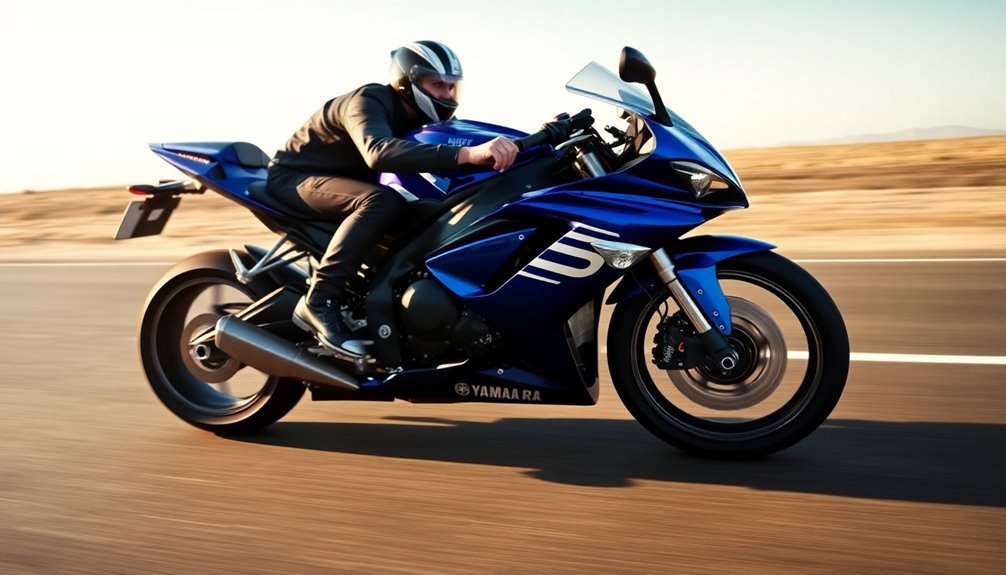
Owners of the Yamaha R1 often share exhilarating stories that highlight the bike's impressive performance on the road. You might find yourself captivated by the 2012 model, which can hit 105 mph in first gear and reach an astonishing 196 mph on the Autobahn, as confirmed by GPS. Many riders report pushing their 2012 R1 to 173 mph in fifth gear, showcasing its ability to deliver a thrilling rush of speed.
The smooth power delivery from the crossplane inline-four-cylinder engine allows you to connect effortlessly with the bike, especially when revving up to 8,000 rpm. With advanced features like traction control and a close-ratio gearbox, you'll feel confident navigating tight corners or flying down straightaways. Additionally, the R1 has been recognized as a benchmark in the sportbike category, further solidifying its reputation among enthusiasts.
Owners frequently commend the R1's stability at high speeds, making it a top choice for both the track and the open road. The 2024 model maintains this impressive performance, reaching 99 mph in first gear.
Whether you're a seasoned rider or new to superbikes, you'll likely find the R1's aggressive yet smooth ride to be an unforgettable experience.
Market Positioning Against Rivals
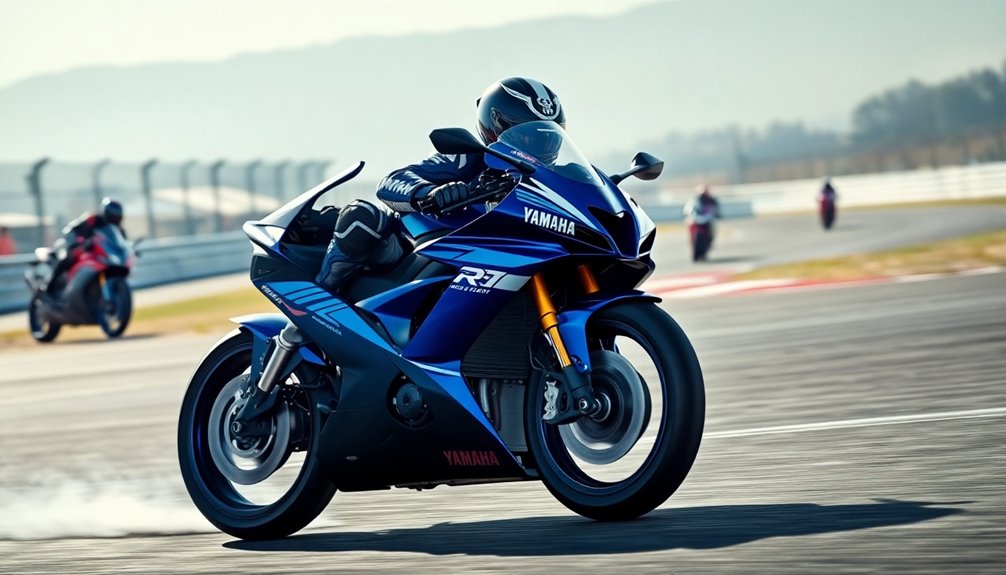
In the competitive world of superbikes, Yamaha's R1 stands out, but it faces stiff challenges from rivals like the BMW S 1000 RR and Ducati models. With a power output of 197 horsepower, the R1 falls short against the BMW's 210 HP, yet it compensates with impressive torque at 83 LB-FT, placing it on par with its competitors.
You'll appreciate the R1's rapid acceleration and refined power delivery, ensuring exhilarating rides. The R1 GYTR model is designed with customizable features that cater to all ability levels, enhancing its appeal to a broader audience.
Technologically, the R1 boasts MotoGP-derived features, like aerodynamic winglets and advanced electronics, enhancing its track performance. Fully adjustable KYB suspension and updated Brembo brakes further improve handling and braking efficiency.
The R1's pricing at $18,999 may seem steep compared to rivals, but its racing heritage and customizable options through GYTR PRO Shops offer unique value.
While brands like MV Agusta and Suzuki's GSX-R1000RR pose significant competition with their own powerful offerings, the R1 remains a strong contender, especially for those who value track-focused performance and heritage.
Ultimately, Yamaha's engineering and racing legacy continue to keep the R1 relevant in this fierce market.
Enhanced Exhaust System Benefits
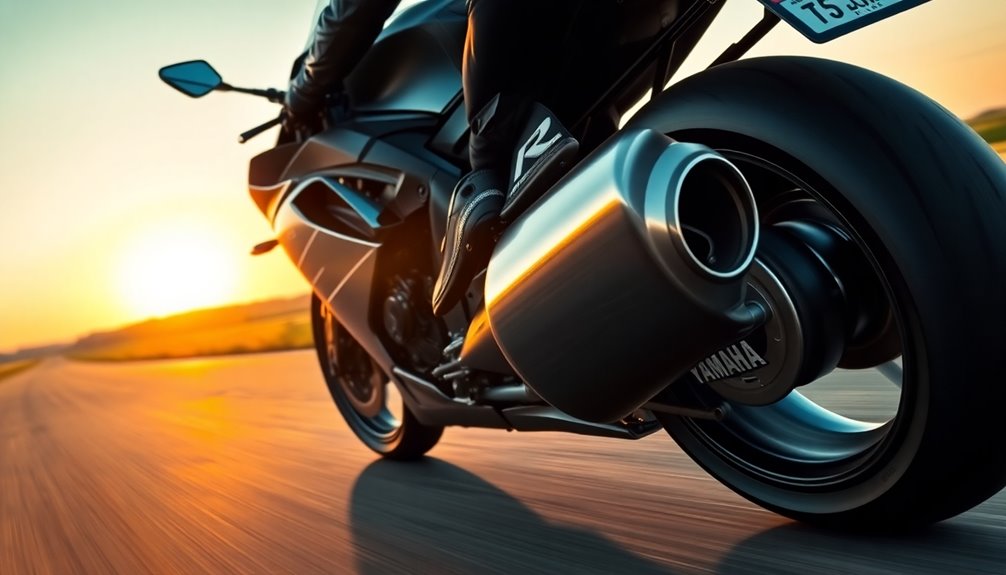
The Yamaha R1's performance can be further enhanced with an upgraded exhaust system, providing significant benefits that elevate the riding experience.
Aftermarket exhausts can increase horsepower, especially full systems that deliver more substantial gains than slip-ons. By reducing back pressure, these systems allow your engine to breathe better, resulting in faster acceleration and improved torque. You'll notice enhanced throttle response, making your bike more agile and responsive.
Weight reduction is another crucial advantage. Many aftermarket exhausts use lighter materials like titanium and carbon fiber, improving your bike's overall power-to-weight ratio. This weight savings enhances handling, making the R1 feel more maneuverable and easier to control on the road or track. Lighter aftermarket options not only contribute to this weight reduction but also positively impact the bike's overall performance.
Additionally, an upgraded exhaust system offers a distinctive sound that adds to the thrill of riding. You can choose from various sound profiles, from aggressive to refined, allowing you to customize your experience.
With compliance options for noise regulations, you can enjoy this auditory enhancement without worry. Overall, upgrading your exhaust system not only boosts performance but also transforms your riding experience into something truly exhilarating.
Cost and Dealer Options
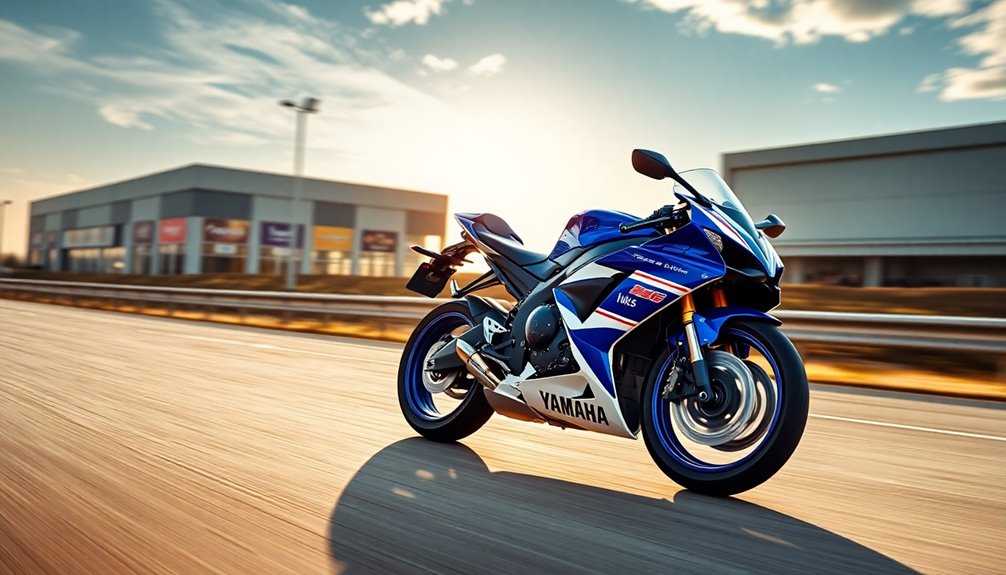
When considering the cost of a Yamaha R1, you'll find the 2024 model priced at $18,399 and the 2025 model at $18,999, reflecting a $600 increase.
If you're looking to finance your purchase, many dealers offer low-interest financing and no payments for 45 days with approved credit, making it easier to bring home your dream bike. Additionally, you can expect a 12-month warranty with your new motorcycle, providing peace of mind during your ownership.
It's also wise to check with your local dealers for availability and pricing, as these can vary.
For those with other vehicles to trade in, dealers often accept motorcycles, boats, and more, providing quotes even if you didn't purchase the trade-in from them.
You'll have access to genuine Yamaha accessories, which also come with financing options.
Plus, many dealerships provide full maintenance programs that can last up to five years on new machines.
You can find dealerships in various regions, such as Coloma, MI, and Salt Lake City, UT.
They also stock a range of safety equipment and powersports vehicles, ensuring you have everything you need for your riding adventures.
Performance-Focused Motorcycle Enthusiasts
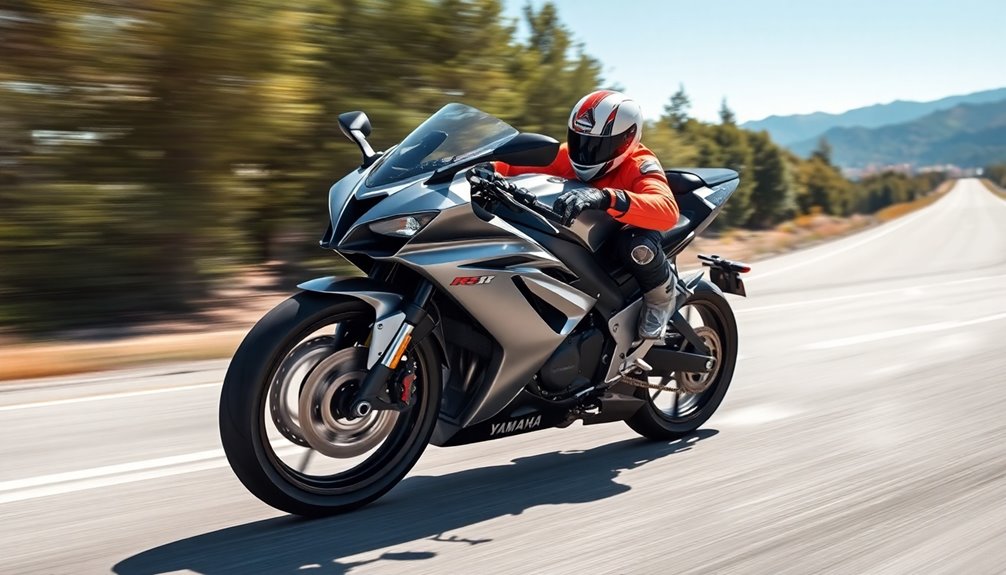
For performance-focused motorcycle enthusiasts, the Yamaha R1 delivers an exhilarating experience that combines raw power with cutting-edge technology.
You'll feel the adrenaline rush as the R1 accelerates from 0 to 60 mph in just 3.10 seconds, pushing you to 100 mph in a mere 5.73 seconds. With a top speed of 191 mph—potentially reaching 200 mph with some modifications—this bike is engineered for those who crave speed.
The R1's 197 horsepower at the crank, and up to 202 with ram air, ensures you have the power necessary for thrilling rides. Its cross-plane crankshaft technology contributes to a unique power delivery that enhances traction, while the YCC-T throttle control provides precise throttle response, making every ride feel intuitive.
The fully adjustable suspension and lightweight Deltabox aluminum frame allow for agile handling, whether you're carving through corners on a track or cruising down the highway.
Plus, with a quarter-mile time of just 10.10 seconds, you'll dominate the drag strip. For those who demand performance, the Yamaha R1 is a machine designed to fulfill your wildest riding ambitions.
Frequent Electrical System Failures
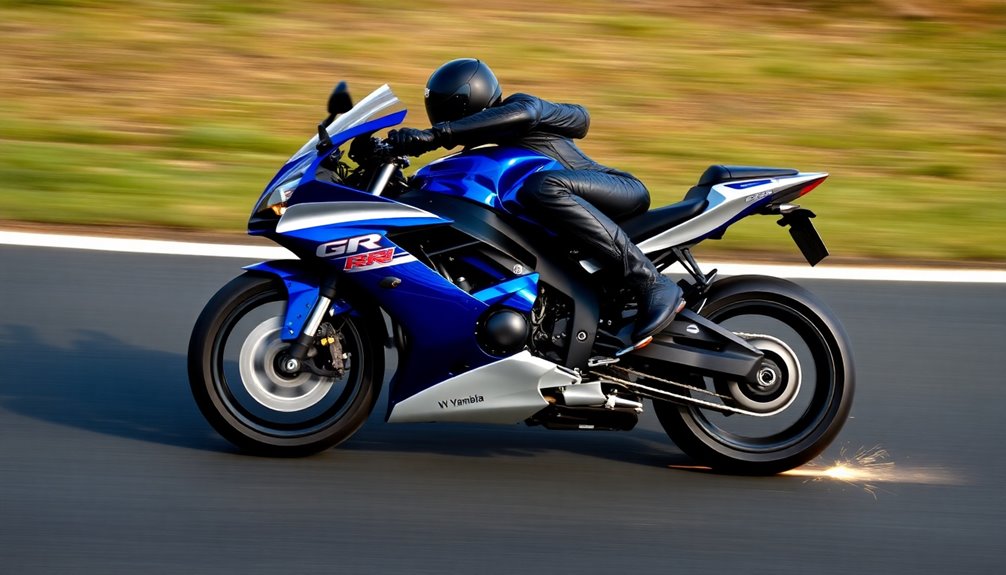
Experiencing frequent electrical system failures can be frustrating for Yamaha R1 owners, affecting both performance and reliability. One common issue is battery voltage; it should measure around 13.3-13.5 volts after charging. If it's below 12.5 volts, your battery may need replacing.
When you rev the engine to 5000 rpm, check the charging system—voltages should be between 14-14.5 volts. Anything outside this range suggests problems with the rectifier/regulator or alternator. Regularly checking connections for oxidation/corrosion can help prevent further electrical issues.
You should also inspect the stator coil by measuring the resistance between terminals; a reading of 0.45-0.55 ohms at 20°C is ideal. If you see incorrect values, replacing the stator coil is necessary.
Additionally, blown fuses, especially the main 30 amp or EFI fuses, can lead to failures. Malfunctions in throttle/pedal position sensors may activate warning codes, while accessories like the Yamaha lap timer could drain your battery.
Watch for symptoms like engine stalling, limp mode activation, or a dim dash. For diagnostics, use a digital voltmeter and an ohmmeter.
If you identify issues, consult your manuals to replace the faulty components and restore your bike's performance.
Crash Avoidance Technologies
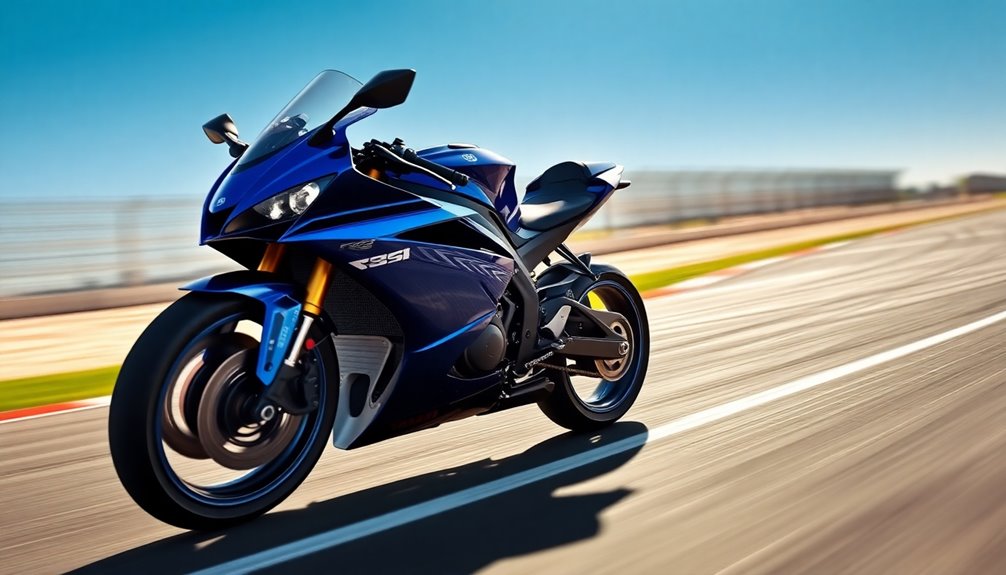
Incorporating cutting-edge crash avoidance technologies, the Yamaha R1 enhances rider safety and confidence on the road and track.
With its advanced electronics package, you can take advantage of a Traction Control System (TCS) that minimizes rear wheel spin during corner exits and offers ten customizable settings. The Slide Control System (SCS) detects and manages slides during aggressive leaning, adjustable across four settings to suit your riding style.
Launch Control helps you manage power output effectively when accelerating from a standstill, ensuring you get off to a strong and controlled start.
You'll also find multiple power modes to tailor engine performance based on riding conditions, along with a Quick Shifter that allows for seamless, clutchless gear changes, enhancing your ride experience.
The Unified Braking System (UBS) prevents unwanted rear-end motion during braking, while Racing ABS optimizes stopping power, particularly on the track. Additionally, the optimized brake force distribution adapts to your bike's attitude and lean angle, providing confidence in critical moments. To further protect your investment, consider adding a Crash Cage designed specifically for Yamaha R1 models, which enhances durability and safety during potential falls.
Together, these features ensure that you're equipped to avoid potential crashes, making your ride safer and more enjoyable.
Performance Meets Innovation
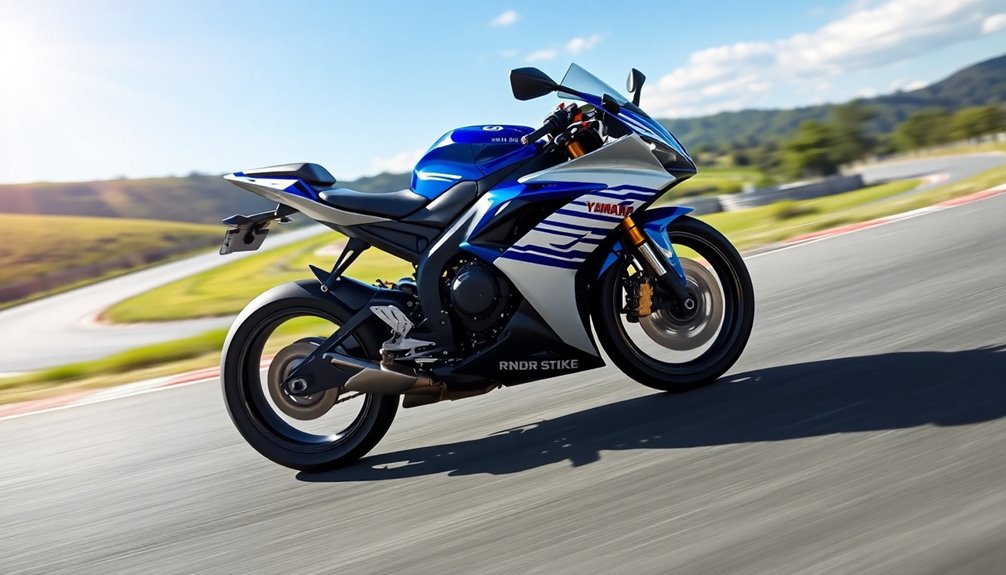
Rider safety doesn't just stop at crash avoidance; it extends into the realm of performance and innovation.
With the Yamaha R1's cutting-edge 998cc inline-four-cylinder engine, you're not just riding; you're experiencing technology derived from Yamaha's YZR-M1 MotoGP® race bike. The engine's crossplane crankshaft design, paired with titanium components, keeps weight down while delivering a staggering 197 HP at 13,500 rpm and 112.4 Nm of torque at 11,500 rpm. The R1's 998 cc inline-four engine remains a core component that enhances its performance capabilities.
Shifting is a breeze with the 6-speed transmission and a slipper clutch that ensures confident downshifts. The ride-by-wire Yamaha Chip Controlled Throttle (YCC-T®) system gives you precise control over power delivery, while the YCC-I® adjusts intake length for an optimal power spread.
The R1's six-axis IMU enhances stability, allowing for lean-sensitive traction and brake control, ensuring you stay in command during intense maneuvers.
With acceleration from 0-60 mph in just 3.10 seconds and a top speed nearing 200 mph, you'll find that performance and safety blend seamlessly, making every ride exhilarating yet secure.
Frequently Asked Questions
What Is the Yamaha R1's Top Speed in Miles per Hour?
The Yamaha R1's top speed is around 186 miles per hour. This limit is mainly due to an agreement among motorcycle manufacturers, designed to prevent regulatory restrictions.
Even though you might expect higher speeds from such a powerful bike, this cap helps manage public safety concerns.
With its impressive engine and acceleration, the R1 still offers an exhilarating ride, making it a top choice for sport bike enthusiasts despite the speed limitation.
How Does the R1 Compare to Earlier Models in Speed?
When you compare the R1 to earlier models, you'll notice significant advancements in speed and acceleration.
The current model tops out at 186 mph, similar to the 2015-2019 models, but you'll find earlier versions maxing around 180 mph.
Acceleration has improved too; the latest model goes from 0-60 mph in about 2.6 seconds, while older models lag behind.
What Factors Affect the R1's Top Speed Performance?
Several factors affect your R1's top speed performance. The engine's displacement and power output play crucial roles, while the aerodynamic design minimizes drag.
Weight is another key factor; a lighter bike accelerates more efficiently. Additionally, the electronic speed limiter caps top speed, but tuning can help you exceed that limit.
Finally, high-performance tires and advanced suspension systems enhance stability and handling, allowing you to push the bike to its limits safely.
Are There Aftermarket Modifications to Increase the R1's Speed?
Yes, there are several aftermarket modifications you can make to increase your R1's speed.
ECU tuning or flashing can boost horsepower significantly, while suspension upgrades like Öhlins or KYB components improve handling.
Adding carbon fiber winglets enhances aerodynamics, and upgrading to Brembo brakes gives you better stopping power.
Each modification helps you maximize your bike's performance, ensuring a thrilling ride on both the street and the track.
What Are the Safety Features at High Speeds on the R1?
When you ride the R1 at high speeds, its advanced safety features keep you secure.
The Lean Angle-Sensitive Traction Control System adjusts to wheel speeds, minimizing spin. You'll appreciate the Anti-wheelie Lift Control System, which prevents the front wheel from lifting during acceleration.
The Brake Control System works with ABS to reduce slip on tricky surfaces, ensuring you maintain control.
These systems enhance your confidence, allowing you to focus on the ride.
